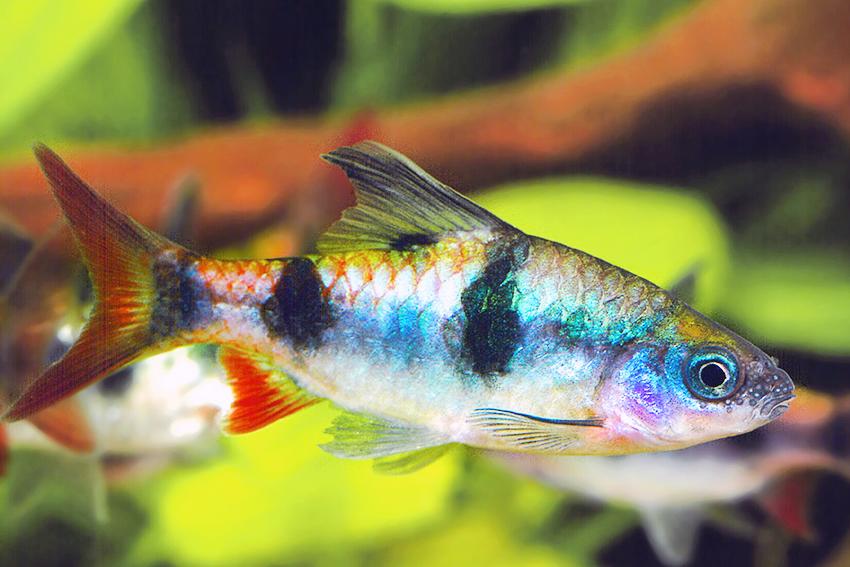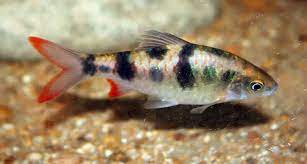Arulius Barb
The Arulius Barb – Puntius arulius, is a friendly yet lively freshwater fish that hails from the barb species. Although the Arulius barb may not be as vibrant as its counterparts, it boasts an appealing appearance and sturdy nature, making it a primary species in a large, diverse community aquarium. However, due to its size, this fish demands a larger aquarium and pristine water conditions, making it more suitable for seasoned aquarium enthusiasts.
- Experience Level: Intermediate
- Hardiness: Hardy
- Minimum Tank Size: 40 gal (150 L)
- Maximum Size: 5 inches (13 cm)
- Temperament: Peaceful
- Temperature: 66 – 77° F (18 – 25° C)
- pH Range: 6 – 8
- Water Hardness: 8 – 12 dGH
- Diet: Omnivore
Table of Contents
Introduction
Size and Appearance
Care Guide
Tank Mates
Diet and Feeding
Breeding
The Arulius barb is commonly found in the Thamirabarani River basin located in Southeast India. It’s a small river, approximately 128 km in length, and has a distinctive red hue due to high levels of copper saturation. This river is home to various unique and endemic fish species.
Numerous factors such as pollution, sand mining, and natural calamities like droughts have posed a threat to these species, including the Arulius barb. As a result, Arulius barbs currently available in the market are predominantly bred in commercial farms for the ornamental fish industry.
Size and Appearance
Both female and male Arulius barbs sport two large black blotches on their flanks along with two or three smaller ones near their gills and tail. The anal and caudal fins generally exhibit red to orange fringing, and the dorsal fin typically exhibits a soft feel and is frequently striped in grey or black. Male Arulius barbs have notably longer, feathered dorsal fins making them potential targets for fin-nipping tank mates.
The Arulius barb has a shape reminiscent of a carp, tapering at the head and tail ends, broadening in the middle of their backs. Their lateral body is as extensive as their tail, enabling them to navigate speedily and adeptly around the tank.
A well-maintained Arulius barb can reach up to 5 inches in size and live for 4 to 6 years. This species is known to reproduce comfortably in captivity.
Care Guide
- Minimum Tank Size: 40 gal (150 L)
- pH Range: 6 – 8
- Water Hardness: 8 – 12 dGH
- Temperature: 66 – 77° F (18 – 25° C)
- Lighting: Low to Moderate, diffused lighting
- Substrate: Dark sand/gravel
- Brackish: No
- Water Flow: Weak/Low
- Tank Region: All areas
Arulius barbs are known for their resilient nature. They tend to adapt to diverse aquarium conditions as long as the water is regularly cleaned and maintained. Being schooling species, they thrive in groups of eight or more. In isolation or as a pair, Arulius barbs tend to lose color vibrancy.
Given their size, the Arulius barb requires a minimum horizontal tank space of 40 gallons. For an active and varied community, consider expanding the tank up to 100 gallons.
The fish prefer oxygenated and flowing water – to replicate this environment in your aquarium, implement a strong filtration system that generates a subtle current and keeps plant life gently swaying.
A regular aquarium lighting setup is ideal for these fish. They are also known to appreciate hiding spots. Consider using rooted plants like guppy grass or pothos, planted in standard aquarium sand. By positioning the plants at the rear and sides of the tank, you provide the Arulius barb with ample swimming space and hiding spots.
Incorporate bottom structures like mangrove roots and rocks to provide the fish with an area to explore and promote overall well-being which, in turn, encourages the display of their vibrant colors.
Tank Mates
Arulius barbs are generally peaceful with any fish small enough not to be considered food. They are excellent for community aquariums housing medium-sized species with similar water temperature and quality requirements.
Arulius barbs are at their calmest when kept in schools of eight or more and coexist happily with other species such as:
- Cherry Barb: Recognized by their appealing cherry tone, Cherry Barbs are one of the most popular barb species. They usually grow up to two inches and have an average lifespan of five years.
- Gold Barb: This brightly-colored, orange-finned species is also labeled as the Chinese barb. Gold Barbs can reach up to three inches in size and typically live up to six years.
- Goldfish: Smaller species like the Common, Comet, and Shubunkin goldfish make suitable tank mates. These types of goldfish can grow up to six inches.
- Zebra Danio: With similar size, temperament, and water temperature preferences, Zebra Danios make excellent tank mates for the Arulius barb. You’ll appreciate their beautiful blue hues.
- Mollies: Mollies are peaceful omnivores and tolerant of colder water temperatures. Varieties like the Common Black Molly add a rich contrast to your aquarium.
- Corydoras: Like Plecos, Corydoras are a type of bottom-feeding catfish commonly placed in freshwater aquariums. They grow up to four inches long and are peaceful omnivores.
Feeding Guide
- Diet: Omnivore
- Frequency: Several small feedings per day
- Pellet Foods: Yes
- Flake Foods: Yes
- Live Foods: Yes
- Meat Foods: Yes
- Vegetable Foods: Yes, will often take partly cooked, dark leafy greens
As enthusiastic omnivores, Arulius barbs consume both flaked and pelleted tropical fish feed as well as a mix of both live and frozen food. To avoid your fish getting dependent on one type of food, it’s recommended to alternate their diets with:
• Live or freeze-dried brine shrimp
• Live or freeze-dried bloodworms
• Finely chopped vegetables such as squash or zucchini
• Diced earthworms
Due to their peaceful nature, Arulius barbs may not aggressively compete for food with mid- or lower-level dwellers. It’s beneficial to feed them two small meals per day as this also keeps them entertained. Remember to keep their diet diverse.
Breeding
Arulius barbs are relatively easy to breed in larger tanks where they feel they have ample space or in average-sized aquariums that house isolated breeding pairs.
In their native habitat, Arulius barbs reproduce when warmer monsoon waters soften the water conditions. You can stimulate such conditions by providing warmer water, dim light, and a substantial diet of frozen or live brine shrimp and bloodworms. Increase the water temperature to between 75–80°F / 24–26 (27)°C.
Males in spawning conditions portray white spots around their mouth area. If you’re unsure about what you’re observing, compare all the male individuals in your tank to identify similar spawning signs.
You can either group spawn or isolated the Arulius barbs into separate aquariums. Group spawning guarantees more viable eggs but increases the risk of adult fish consuming their eggs or fry. If you lack the resources for additional aquariums, ensure you have dense vegetation like guppy grass or java moss to provide shelter for the fry.
Upon release, the fish scatter and fertilize their eggs at the bottom of the tank. A substrate like gravel is essential for hiding the eggs from their absent-minded parents and other bottom-feeders who may consume them. The eggs will hatch after 24 to 48 hours, and the fry will become free-swimming after another day. The initial diet of Arulius barb fry should consist of extremely small foods like infusoria. However, after approximately a week, they should be capable of consuming smaller brine shrimp and similar foods.



